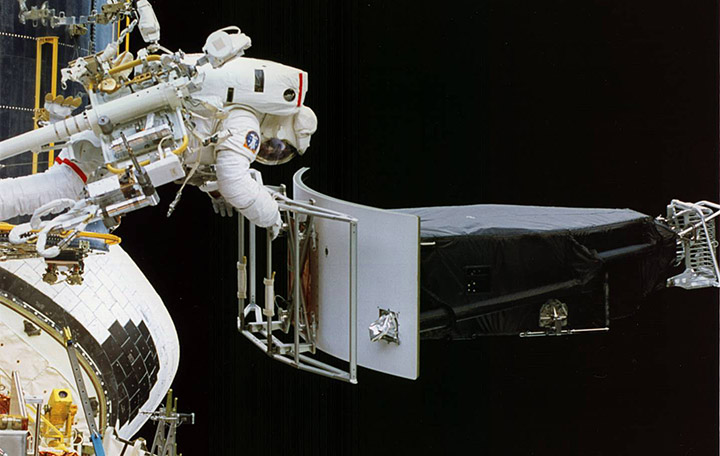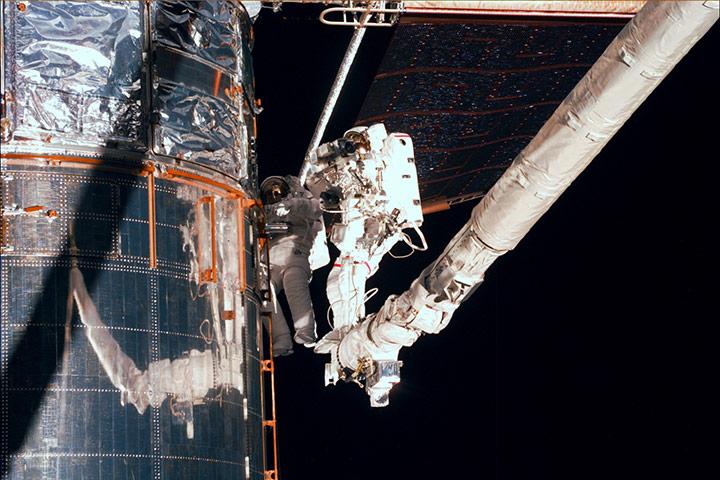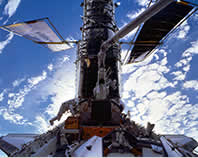Astronomy
 Hubble was designed to be one of the greatest telescopes. It operates in space, where there are no clouds, atmosphere or anything else to get in its way to take great pictures.
Hubble was designed to be one of the greatest telescopes. It operates in space, where there are no clouds, atmosphere or anything else to get in its way to take great pictures.
 But, immediately after deployment, a problem became clear. The main mirror was flawed, suffering from spherical aberration, or simply imperfection! So a servicing mission, in December 1993, was sent out to fix this flaw (Servicing Mission 1, see picture at left). Spending five days to work on this, the astronauts installed two devices, Wide Field and Planetary Camera 2 and the Corrective Optics Space Telescope Axial Replacement.
But, immediately after deployment, a problem became clear. The main mirror was flawed, suffering from spherical aberration, or simply imperfection! So a servicing mission, in December 1993, was sent out to fix this flaw (Servicing Mission 1, see picture at left). Spending five days to work on this, the astronauts installed two devices, Wide Field and Planetary Camera 2 and the Corrective Optics Space Telescope Axial Replacement.
 For Servicing Mission 2, in February 1997, the humongous telescope was outfitted with the Near Infrared Camera and Multi-Object Spectrometer, in order to see our universe in infrared wavelength. Astronauts also installed the Space Telescope Imaging Spectrograph.
For Servicing Mission 2, in February 1997, the humongous telescope was outfitted with the Near Infrared Camera and Multi-Object Spectrometer, in order to see our universe in infrared wavelength. Astronauts also installed the Space Telescope Imaging Spectrograph.
 For Servicing Mission 3A, the telescope received a major hardware update. Among the new items added were gyroscopes and a replacement of one of the three Fine Guidance Sensors (you can see this in the picture at left). This improvement for the Hubble made it like new again. The telescope was deployed back into space on December 25, 1999.
For Servicing Mission 3A, the telescope received a major hardware update. Among the new items added were gyroscopes and a replacement of one of the three Fine Guidance Sensors (you can see this in the picture at left). This improvement for the Hubble made it like new again. The telescope was deployed back into space on December 25, 1999.
 In Servicing Mission 3B (NASA split Servicing Mission 3 into two parts, that's why there's 3A and 3B), in March of 2002, the seven member crew of Columbia installed the Advanced Camera for Surveys, or ACS, (see picture at right) with a wide field of view and better image quality than the previous surveying instrument, the Wide Field and Planetary Camera 2. The solar panels were replaced as well, with four new large and flexible panels. These panels produce 30 percent more power than the old ones. Along with this change, the original Power Control Unit was changed, too. This change required the telescope to power down for the first time after its launch in 1990. A new cooling system was added on to the Near Infrared Camera and Multi-Object Spectrometer, because the previous one had used up its nitrogen ice, and new steering equipment was added on as well.
In Servicing Mission 3B (NASA split Servicing Mission 3 into two parts, that's why there's 3A and 3B), in March of 2002, the seven member crew of Columbia installed the Advanced Camera for Surveys, or ACS, (see picture at right) with a wide field of view and better image quality than the previous surveying instrument, the Wide Field and Planetary Camera 2. The solar panels were replaced as well, with four new large and flexible panels. These panels produce 30 percent more power than the old ones. Along with this change, the original Power Control Unit was changed, too. This change required the telescope to power down for the first time after its launch in 1990. A new cooling system was added on to the Near Infrared Camera and Multi-Object Spectrometer, because the previous one had used up its nitrogen ice, and new steering equipment was added on as well.
Originally, NASA was planning not to conduct any further service missions, due to concerns about safety of the space shuttle. But now, a future servicing mission is planned as well, called Service Mission 4. The mission will work on replacing outdated and old equipment, like the Fine Guidance Sensor, on the telescope and make sure the telescope is in top shape. Right now, this mission is planned for September 2008.
For more information, visit:
- Shuttle Atlantis Blasting From Nasa
When the space shuttle Atlantis blasts off on NASA's final mission to service the Hubble Space Telescope, the shuttle Endeavour and a four-man crew will be standing by for launch on a mission space agency managers hope will never be needed: an emergency...
- Space Shuttle Endeavour Travels From Hangar To The Vehicle Assembly Building
In preparation for its role as a standby rescue craft during the Hubble Space Telescope servicing mission and its scheduled June construction flight to the international space station, shuttle Endeavour rolled from the hangar to the Vehicle Assembly...
- A "perfect Ten" For The Hubble Space Telescope
Arp 147Image: NASA A few weeks after the Hubble Space Telescope went into sleep mode, due to an electrical malfunction, it came back with a marvelous photo of two adjacent galaxies, resembling a number "10". The image came just a few days after the...
- Some Hubble Space Telescope History
By Jarrod Roby The Hubble Space Telescope, named after Edwin Hubble, was built by NASA, and launched into space in 1990. At the time, astronomers the world over expected great discoveries to be made. With this magnificent telescope's help, we could...
- The Amazing Hubble Telescope
In the history of modern astronomy, there is probably no one greater leap forward than the building and launch of the space telescope known as the Hubble. While NASA has had many ups and downs, the launch and continued operation of the Hubble space...
Astronomy
Hubble's Servicing Missions
 Hubble was designed to be one of the greatest telescopes. It operates in space, where there are no clouds, atmosphere or anything else to get in its way to take great pictures.
Hubble was designed to be one of the greatest telescopes. It operates in space, where there are no clouds, atmosphere or anything else to get in its way to take great pictures.  But, immediately after deployment, a problem became clear. The main mirror was flawed, suffering from spherical aberration, or simply imperfection! So a servicing mission, in December 1993, was sent out to fix this flaw (Servicing Mission 1, see picture at left). Spending five days to work on this, the astronauts installed two devices, Wide Field and Planetary Camera 2 and the Corrective Optics Space Telescope Axial Replacement.
But, immediately after deployment, a problem became clear. The main mirror was flawed, suffering from spherical aberration, or simply imperfection! So a servicing mission, in December 1993, was sent out to fix this flaw (Servicing Mission 1, see picture at left). Spending five days to work on this, the astronauts installed two devices, Wide Field and Planetary Camera 2 and the Corrective Optics Space Telescope Axial Replacement. For Servicing Mission 2, in February 1997, the humongous telescope was outfitted with the Near Infrared Camera and Multi-Object Spectrometer, in order to see our universe in infrared wavelength. Astronauts also installed the Space Telescope Imaging Spectrograph.
For Servicing Mission 2, in February 1997, the humongous telescope was outfitted with the Near Infrared Camera and Multi-Object Spectrometer, in order to see our universe in infrared wavelength. Astronauts also installed the Space Telescope Imaging Spectrograph. For Servicing Mission 3A, the telescope received a major hardware update. Among the new items added were gyroscopes and a replacement of one of the three Fine Guidance Sensors (you can see this in the picture at left). This improvement for the Hubble made it like new again. The telescope was deployed back into space on December 25, 1999.
For Servicing Mission 3A, the telescope received a major hardware update. Among the new items added were gyroscopes and a replacement of one of the three Fine Guidance Sensors (you can see this in the picture at left). This improvement for the Hubble made it like new again. The telescope was deployed back into space on December 25, 1999. In Servicing Mission 3B (NASA split Servicing Mission 3 into two parts, that's why there's 3A and 3B), in March of 2002, the seven member crew of Columbia installed the Advanced Camera for Surveys, or ACS, (see picture at right) with a wide field of view and better image quality than the previous surveying instrument, the Wide Field and Planetary Camera 2. The solar panels were replaced as well, with four new large and flexible panels. These panels produce 30 percent more power than the old ones. Along with this change, the original Power Control Unit was changed, too. This change required the telescope to power down for the first time after its launch in 1990. A new cooling system was added on to the Near Infrared Camera and Multi-Object Spectrometer, because the previous one had used up its nitrogen ice, and new steering equipment was added on as well.
In Servicing Mission 3B (NASA split Servicing Mission 3 into two parts, that's why there's 3A and 3B), in March of 2002, the seven member crew of Columbia installed the Advanced Camera for Surveys, or ACS, (see picture at right) with a wide field of view and better image quality than the previous surveying instrument, the Wide Field and Planetary Camera 2. The solar panels were replaced as well, with four new large and flexible panels. These panels produce 30 percent more power than the old ones. Along with this change, the original Power Control Unit was changed, too. This change required the telescope to power down for the first time after its launch in 1990. A new cooling system was added on to the Near Infrared Camera and Multi-Object Spectrometer, because the previous one had used up its nitrogen ice, and new steering equipment was added on as well.Originally, NASA was planning not to conduct any further service missions, due to concerns about safety of the space shuttle. But now, a future servicing mission is planned as well, called Service Mission 4. The mission will work on replacing outdated and old equipment, like the Fine Guidance Sensor, on the telescope and make sure the telescope is in top shape. Right now, this mission is planned for September 2008.
For more information, visit:
- HubbleSite (Servicing Missions, Servicing Mission 4)
- SPACE.com
- Shuttle Atlantis Blasting From Nasa
When the space shuttle Atlantis blasts off on NASA's final mission to service the Hubble Space Telescope, the shuttle Endeavour and a four-man crew will be standing by for launch on a mission space agency managers hope will never be needed: an emergency...
- Space Shuttle Endeavour Travels From Hangar To The Vehicle Assembly Building
In preparation for its role as a standby rescue craft during the Hubble Space Telescope servicing mission and its scheduled June construction flight to the international space station, shuttle Endeavour rolled from the hangar to the Vehicle Assembly...
- A "perfect Ten" For The Hubble Space Telescope
Arp 147Image: NASA A few weeks after the Hubble Space Telescope went into sleep mode, due to an electrical malfunction, it came back with a marvelous photo of two adjacent galaxies, resembling a number "10". The image came just a few days after the...
- Some Hubble Space Telescope History
By Jarrod Roby The Hubble Space Telescope, named after Edwin Hubble, was built by NASA, and launched into space in 1990. At the time, astronomers the world over expected great discoveries to be made. With this magnificent telescope's help, we could...
- The Amazing Hubble Telescope
In the history of modern astronomy, there is probably no one greater leap forward than the building and launch of the space telescope known as the Hubble. While NASA has had many ups and downs, the launch and continued operation of the Hubble space...
